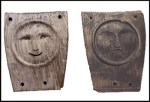I’ve been asking the question, “What is Native science?” since landing in Washington DC for my summer fellowship at the National Museum of the American Indian. The Yup’ik have no word for science, according to a traveling exhibit now at the Museum of Natural History. That makes the question even harder to answer.
The Alaskan Yup’ik, who live along the Bering Sea Coast, are the subject of the captivating exhibit created with the Calista Elders Council and the Anchorage Museum. Science, technology, art, spirituality and education are interwoven seamlessly into the exhibit, a testament to what the press materials call “the intelligence and ingenuity of this ancient culture.”
In the west, we bracket science under its own pillar. We take science classes in elementary school and go to universities where the science programs are tucked under roofs separate from business, education and humanities. If we want to know the effect of science on art, we generally turn to art criticism, rather than science, to understand how cubism mirrors Cartesian reductionism.
- Cockpit coaming stanchions
- National Museum of the American Indian
- Seal-Gut Parka
The folks I’ve met at the Smithsonian who are invested in indigenous ways of knowing are working hard to bridge the rift between science and culture. Doug Herman, a senior geographer at the National Museum of the American Indian and my sponsor, hopes to find a way to elevate Native science to an equal status of so-called western science. Native science is typically disparaged as superstition or “merely” anecdotal, and is therefore labeled non-science.
Nowhere does this rift become more marked than in public discourse surrounding Kennewick Man, the 9000 year-old skeleton found in 1996 at the Columbia River in Washington State. Local tribes requested return of the skeleton, arguing that the ancestor is protected under the Native American Graves Protection and Repatriation Act, which oversees return of human remains and artifacts to Indian communities. A group of university professors and two anthropologists from the Smithsonian sued for the opportunity to study Kennewick Man, and the conflict was framed as “science vs. religion.” When the courts ruled against the Indians, news headlines called the decision “A victory for science.” A headline in the London Times opined that “Bones put Indians on the warpath.”
Dorothy Lippert agrees that news media paint simplistic pictures of the conflict, with broad strokes of black and white, right and wrong, us and them. Lippert, an anthropologist (Choctaw) who works in repatriation efforts at the Museum of Natural History, is one of the five editors of a text on Kennewick Man that offers a panoply of perspectives on the issue with a rich infusion of Native views. This is the definitive text on the Kennewick repatriation conflict.
Clearly mass media—where lay publics get much information about science and about Indians—tend to fall back on cartoonish representations. So, if our aim is to present to lay publics information that helps frame Native science as legitimate, we confront a worldview where western science is privileged and sacrosanct. Media are hard pressed to tease out the cultural and value-laden aspects of western science, perhaps assuming that science is value-free.
Which begs the question: What is science?





Wonderful explanation of the “conflict” between the cultural epistomology of native science and the new world explantion of how and why things in our natural world interact and work.
Congratulations to Cindy on her work in D.C!
Rob
LikeLike
Dr Coleman:
Ahhhh. This is just the way I prefer writing to be — Direct, concise, straightforward with basic language and uncomplicated sentences.
Joe Atkin
LikeLike
Thanks for putting this up, Cindy. Your comments about the assumption that science is “value-free” and the fact that we bracket science off from other critical aspects of our lives (business, education, humanities) really speak to me. I look forward to more posts.
LikeLike
I don’t think we can expect the media to answer the question “What is Science”. It is clear that culture and values do frame reporting, though. Perhaps another question worth asking is “How do we train the media to report Native American topics in a fair and balanced way?”.
LikeLike
I concure, and support your direct approach.
LikeLike
I love reading about your work, Cindy. You offer questions that are bubbling up in many areas in the world. In my recent writings with African authors/researchers, a similar issue has surfaced that mirrors your concerns — that of the importance of indigenous, postcolonial research paradigms over positivist and interpretivist Western paradigms. It seems that some people/researchers do not value indigenous perspectives in any field of study, particularly science, where truth is typically measured in terms of objective data through observation or ‘instruments’.
LikeLike